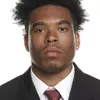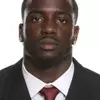Indiana University Athletics

The Doctor is In
8/31/2018 12:20:00 PM | Football
By: Andy Graham
IUHoosiers.com
BLOOMINGTON, Ind. - Speed kills, as the athletic adage goes.
Speed also thrills, as a young David Ballou could attest.
Ballou, as a sophomore fullback on Indiana's 1997 football team, watched small but swift freshman quarterback Antwaan Randle El arrive and shine.
"I just remember saying 'Wow!' pretty much on a daily basis," Ballou, now IU football's Director of Athletic Performance, recalled recently. "… Speed, quickness, toughness, change-of-direction.
"He changed direction, at game speed, better than I've ever seen from anybody else. Obviously, that transferred over into the NFL, too."
Ballou never forgot how those dazzling capacities helped Randle El achieve in the rugged Big Ten and at the sport's elite professional level.
And Ballou has carried that over into a pioneering career developing athletes, addressing the need for explosive power but also speed.
So Ballou, hired by IU last January, was ready when Hoosier head coach Tom Allen made a special request.
Allen said he wasn't sure such a position previously existed anyplace else, but he wanted Ballou to find a "speed specialist" to work with Hoosier football players.
"I have just the guy," Ballou replied.
Enter Dr. Matt Rhea.
And Indiana University would write yet another chapter in its decades-long saga as a vanguard of innovation in the world of intercollegiate athletics.
Because Rhea, Ph.D. in kinesiology, became the first "speed specialist" in the history of college football with a Ph.D.
"The challenge of people thinking that you can't have that much impact on speed is probably what first drew me to it," Rhea observed. "I'm really intrigued by the nervous system and how the brain controls things.
"… Even better, how we can influence the brain to control them better – which is basically what our system is built to do."
Rhea and Ballou developed that data-based system, grounded in science, as kindred spirits in 2015 and 2016 at IMG Academy in Florida – where they trained top prep prospects, college stars and pros.
"Dave Ballou is a really unique guy in this industry," Rhea said. "He's just as interested (as I am) in the data and the science behind it. And he has full faith in me."
And over time, Rhea and Ballou have earned the faith of others.
Such as former IMG parent and current Big Ten Network football analyst Howard Griffith. Griffith's son Houston, previously trained at IMG, is vying to start for Notre Dame at safety as a true freshman.
"He knows them well," Griffith said of his son's familiarity with Ballou and Rhea. "He loves those guys. As far as motivating guys, getting them to train, and using science to do it, it's the new approach.
"I saw the difference, in just a few months, in what my son looked like and was able to do."
Now, when an IU player arrives at a weight rack, a tap of an iPad reveals an individualized workout plan designed specifically for him – to attack weaknesses and maximize gains, built through data accumulated via 3-D cameras, body sensors and other high-tech gear.
There is a laser, for example, that gauges how far and how quickly an athlete is actually moving the bar during lifting.
And all the data is fed into a program that reveals how any given athlete needs to proceed.
Proceed to speed. That is what Allen wants.
"It's a speed game," Allen said. "The game is played in space, and it continues to grow in that area, and I don't see that changing."
But Allen is seeing his squad change. Between February and the start of fall camp, the broad spectrum of speed improvements for IU football players is eye-popping:
There is more power, too. Indiana has five times as many players squat-thrusting 500-or-more pounds now than it did in February. The number of players bench-pressing 400 pounds or more has quadrupled.
Real and rapid progress in such numbers not only brought quick buy-in from IU's players to the methodology of Rhea and Ballou, it should make the Hoosiers a more confident crew heading into a 2018 campaign starting Sept 1 at Florida International.
"Those that have been around this game know the physical piece gives you confidence," Allen said. "There is just a confidence about our guys right now because they know they're bigger, faster, stronger, more explosive, and they feel that way. It affects your mindset.
"So I think that's been another big benefit of Coach Ballou and Dr. Rhea and the work they've done. Obviously, now you've got to go play football. You've got skills that have to be developed and those (sorts of) things, but it starts in that weight room."
And the changes there started with an Indiana administration willing not just to invest in football, but also innovation. Rhea said every request made for equipment and resources had received an affirmative response from IU.
"Nobody has told me 'no,' yet," Rhea said with a smile, "so I'm going to keep asking till somebody says, 'No.' If that never happens, fantastic. But so far the technology and tools we've needed have been given to us, and I'm appreciative of that."
Beyond referencing the new south end zone facility at Memorial Stadium coming on line this fall, Griffith lauded the money spent to not just hire Ballou and Rhea but to also provide their required tools.
"Good people are hard to find," Griffith said. "I think this is one of those things that is just going to continue to build, continue to get better. Throughout the country, not everybody is doing it. I think you have to take your hat off to Indiana for putting the resources behind it. It's not cheap."
Cutting-edge research clearly matters at Indiana University, athletics included.
Speed indeed thrills.
And speed in football, especially these days, wins.
IUHoosiers.com
BLOOMINGTON, Ind. - Speed kills, as the athletic adage goes.
Speed also thrills, as a young David Ballou could attest.
Ballou, as a sophomore fullback on Indiana's 1997 football team, watched small but swift freshman quarterback Antwaan Randle El arrive and shine.
"I just remember saying 'Wow!' pretty much on a daily basis," Ballou, now IU football's Director of Athletic Performance, recalled recently. "… Speed, quickness, toughness, change-of-direction.
"He changed direction, at game speed, better than I've ever seen from anybody else. Obviously, that transferred over into the NFL, too."
Ballou never forgot how those dazzling capacities helped Randle El achieve in the rugged Big Ten and at the sport's elite professional level.
And Ballou has carried that over into a pioneering career developing athletes, addressing the need for explosive power but also speed.
So Ballou, hired by IU last January, was ready when Hoosier head coach Tom Allen made a special request.
Allen said he wasn't sure such a position previously existed anyplace else, but he wanted Ballou to find a "speed specialist" to work with Hoosier football players.
"I have just the guy," Ballou replied.
Enter Dr. Matt Rhea.
And Indiana University would write yet another chapter in its decades-long saga as a vanguard of innovation in the world of intercollegiate athletics.
Because Rhea, Ph.D. in kinesiology, became the first "speed specialist" in the history of college football with a Ph.D.
"The challenge of people thinking that you can't have that much impact on speed is probably what first drew me to it," Rhea observed. "I'm really intrigued by the nervous system and how the brain controls things.
"… Even better, how we can influence the brain to control them better – which is basically what our system is built to do."
Rhea and Ballou developed that data-based system, grounded in science, as kindred spirits in 2015 and 2016 at IMG Academy in Florida – where they trained top prep prospects, college stars and pros.
"Dave Ballou is a really unique guy in this industry," Rhea said. "He's just as interested (as I am) in the data and the science behind it. And he has full faith in me."
And over time, Rhea and Ballou have earned the faith of others.
Such as former IMG parent and current Big Ten Network football analyst Howard Griffith. Griffith's son Houston, previously trained at IMG, is vying to start for Notre Dame at safety as a true freshman.
"He knows them well," Griffith said of his son's familiarity with Ballou and Rhea. "He loves those guys. As far as motivating guys, getting them to train, and using science to do it, it's the new approach.
"I saw the difference, in just a few months, in what my son looked like and was able to do."
Now, when an IU player arrives at a weight rack, a tap of an iPad reveals an individualized workout plan designed specifically for him – to attack weaknesses and maximize gains, built through data accumulated via 3-D cameras, body sensors and other high-tech gear.
There is a laser, for example, that gauges how far and how quickly an athlete is actually moving the bar during lifting.
And all the data is fed into a program that reveals how any given athlete needs to proceed.
Proceed to speed. That is what Allen wants.
"It's a speed game," Allen said. "The game is played in space, and it continues to grow in that area, and I don't see that changing."
But Allen is seeing his squad change. Between February and the start of fall camp, the broad spectrum of speed improvements for IU football players is eye-popping:
- Last year, Indiana had 3 players running at more than 21 MPH. It now has more than 30, with 17 of those running over 22 MPH (which Rhea ranks as elite speed at any level of football).
- All three Hoosier scholarship quarterbacks – Peyton Ramsey, Michael Penix Jr. and Reese Taylor – are running over 22 MPH.
- IU sophomore wideout Whop Philyor and freshman defensive back Jaylin Williams are both running over 23 MPH.
- On average, Indiana has seen a 2.5-3.0 miles-per-hour increase in top speed across the team. That correlates to a .2-.3 improvement in 40-yard sprint time.
There is more power, too. Indiana has five times as many players squat-thrusting 500-or-more pounds now than it did in February. The number of players bench-pressing 400 pounds or more has quadrupled.
Real and rapid progress in such numbers not only brought quick buy-in from IU's players to the methodology of Rhea and Ballou, it should make the Hoosiers a more confident crew heading into a 2018 campaign starting Sept 1 at Florida International.
"Those that have been around this game know the physical piece gives you confidence," Allen said. "There is just a confidence about our guys right now because they know they're bigger, faster, stronger, more explosive, and they feel that way. It affects your mindset.
"So I think that's been another big benefit of Coach Ballou and Dr. Rhea and the work they've done. Obviously, now you've got to go play football. You've got skills that have to be developed and those (sorts of) things, but it starts in that weight room."
And the changes there started with an Indiana administration willing not just to invest in football, but also innovation. Rhea said every request made for equipment and resources had received an affirmative response from IU.
"Nobody has told me 'no,' yet," Rhea said with a smile, "so I'm going to keep asking till somebody says, 'No.' If that never happens, fantastic. But so far the technology and tools we've needed have been given to us, and I'm appreciative of that."
Beyond referencing the new south end zone facility at Memorial Stadium coming on line this fall, Griffith lauded the money spent to not just hire Ballou and Rhea but to also provide their required tools.
"Good people are hard to find," Griffith said. "I think this is one of those things that is just going to continue to build, continue to get better. Throughout the country, not everybody is doing it. I think you have to take your hat off to Indiana for putting the resources behind it. It's not cheap."
Cutting-edge research clearly matters at Indiana University, athletics included.
Speed indeed thrills.
And speed in football, especially these days, wins.
Players Mentioned
FB: Curt Cignetti - Pre-Heisman Press Conference
Wednesday, December 10
FB: Fernando Mendoza - Pre-Heisman Press Conference
Tuesday, December 09
FB: CFP Quarterfinals (Rose Bowl) - Student-Athlete Press Conference
Monday, December 08
FB: CFP Quarterfinals (Rose Bowl) - Curt Cignetti Press Conference
Sunday, December 07









